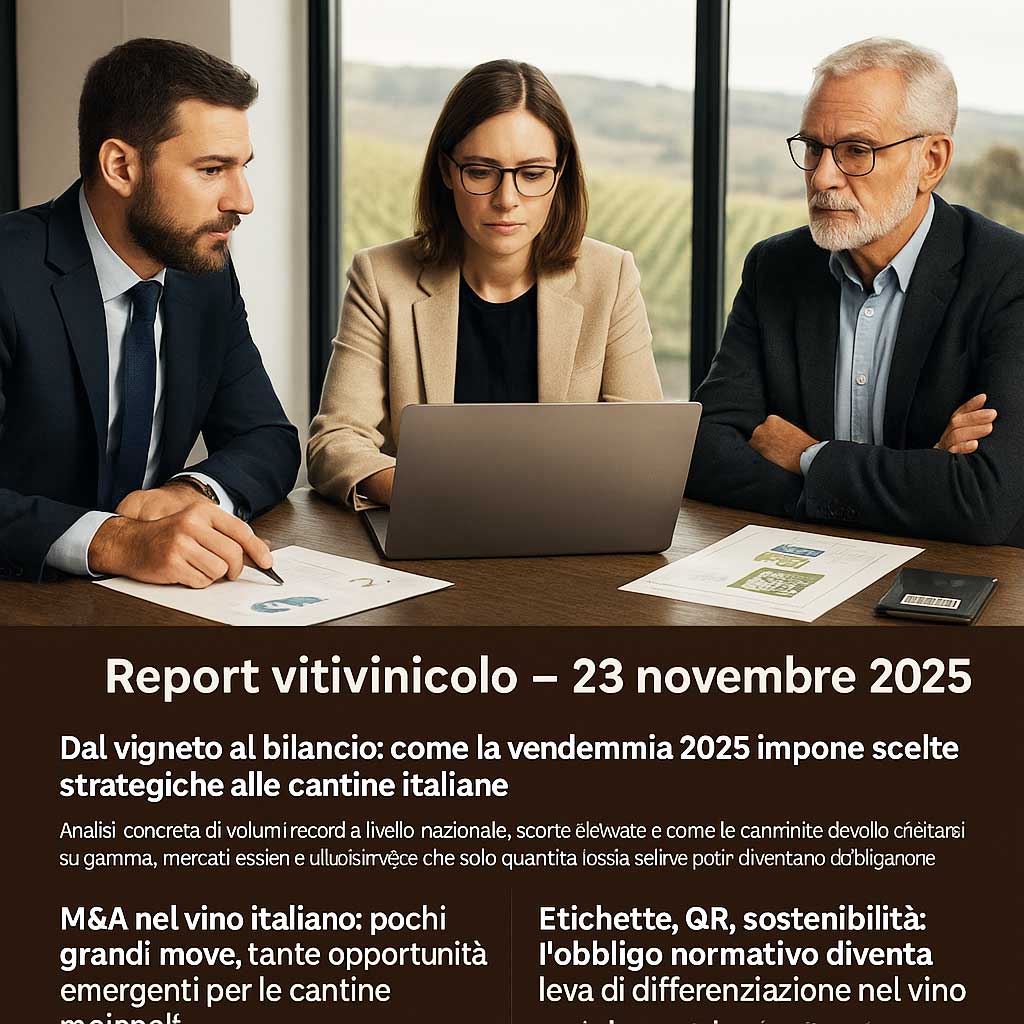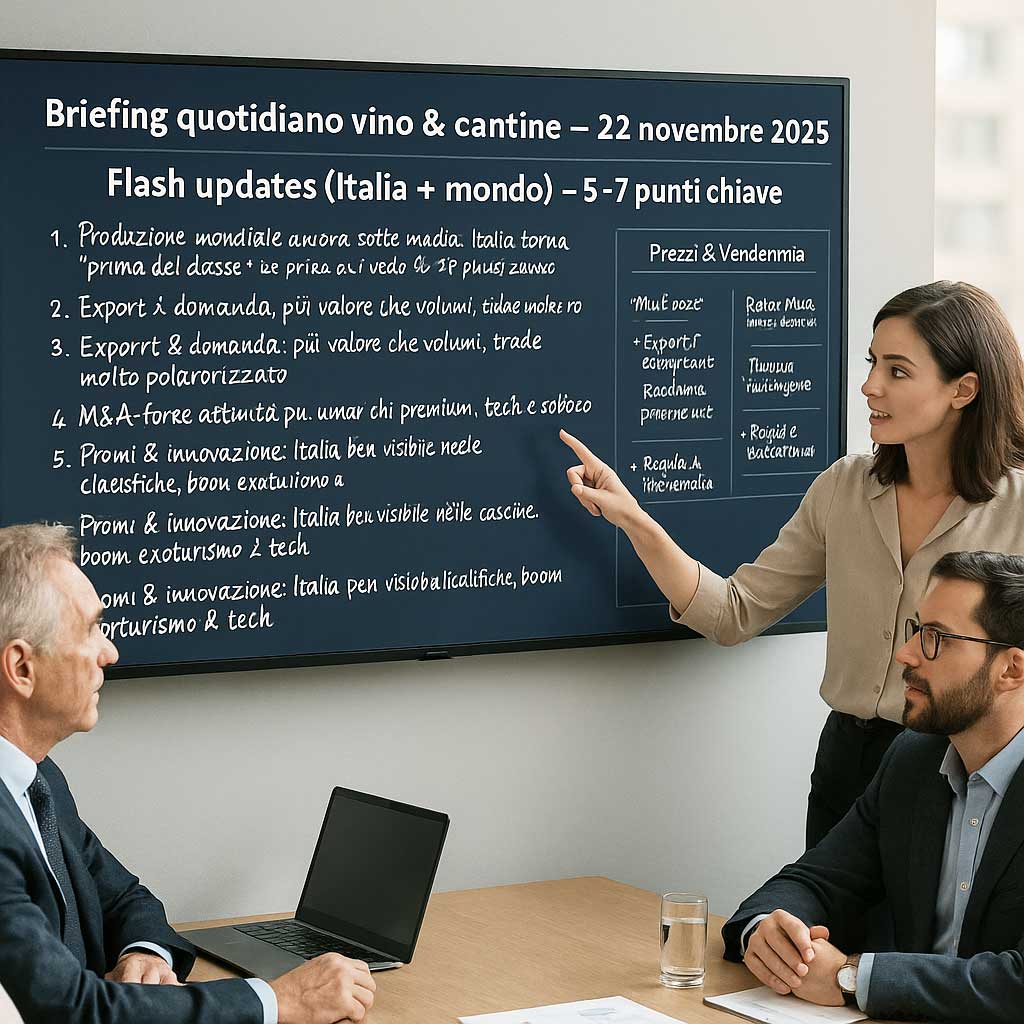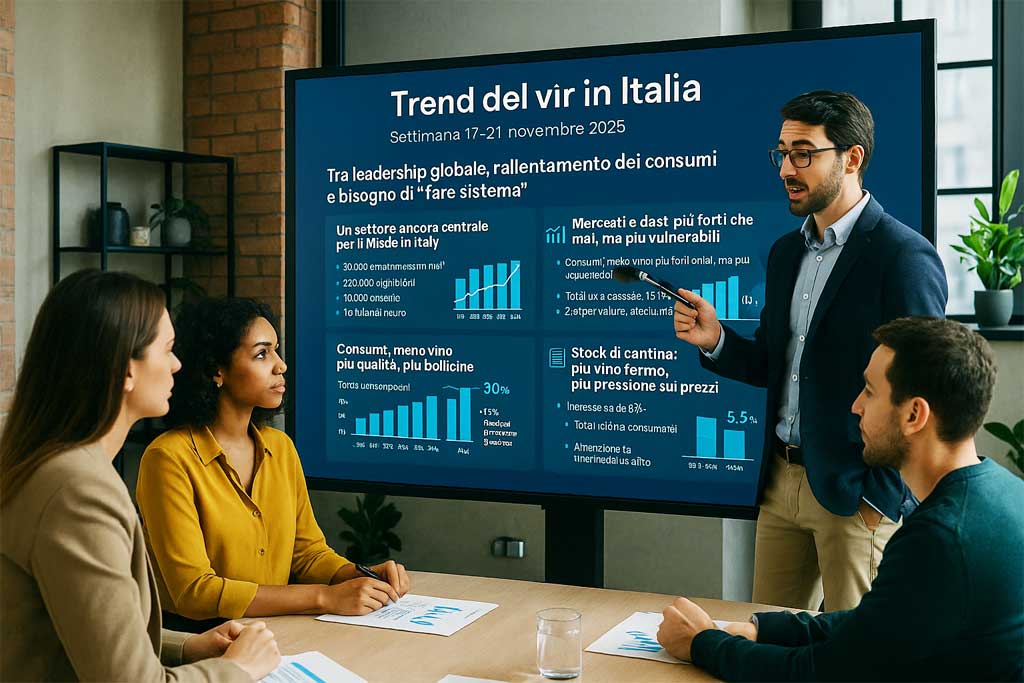Between global leadership, slowing consumption and the need to “work as a system”.
1. A sector still central to Made in Italy
In the week of November 17-21, 2025, the picture emerging from industry meetings, data from Nomisma, ICQRF, OIV, UIV, Confcooperative, and the 2024 financial statements reports is clear:
- Wine remains one of the strategic assets of Made in Italy :
- 30,000 processing companies
- 240,000 agricultural companies
- 74,000 employed
- 16 billion euros in turnover , equal to 9% of the national food and beverage sector
- Exports 2024 at 8.1 billion euros , 14% of agri-food exports:
- Italy is the world’s leading exporter by volume
- 2nd in value , behind France
- From 2014 to 2024, exports went from less than 5 billion to 8.1: a doubling in ten years , despite crises, wars, inflation and the “health wave”.
In 2025, however, the wind has become more complex: in the first 7 months of the year, exports fell by 0.9% , in a context marked by new US duties (15%) , an unfavourable euro/dollar exchange rate and slowing consumption in all the main producing countries.
2. Markets and tariffs: stronger than ever, but more vulnerable
The picture on the markets is twofold: structural strength and cyclical vulnerability.
- United States
- First market for Italian wine: almost 2 billion euros in 2024 (10.2%)
- From 2025 burdened by 15% duties on imports from the EU:
- Actual effects postponed to 2026 price lists , because companies have brought forward shipments to build up stocks
- Risk that the competitive advantage goes to local American producers
- Diversification in progress :
- Canada (15.3%) , Russia (40%) , South America, Eastern Europe, Asia are growing
- Wine e-commerce is estimated to be worth $6.7 billion globally in 2025.
- Geopolitics and global tariffs :
- United States, Canada, China: strong volatility, with a collapse in exports for American producers and indirect impacts for Italy
- The EU is working on a “Wine Package” and new agreements (Mercosur, India, Asia), with more funds for promotion (up to 80% co-financed)
The underlying message: the US market is irreplaceable, but no longer sufficient. 2026 will be a “year of review” for reorientation strategies.
3. Consumption: less wine, more quality, more bubbles
On the internal front the signs are structural:
- Total consumption in long-term decline
- From 1995 to today: -30% , to approximately 23 million hectolitres
- Production, however, remains around 46–47 million hectolitres : half of the wine produced goes abroad.
- Change the mix:
- Sparkling wines account for 15.2% of consumption (almost doubled since 2010)
- Whites remain at 39.6% (stable)
- Rossi drops to 37.3% (from 43.9% in 2010)
- The consumer changes:
- Fewer “everyday consumers” (from 55% in 2008 to 40% in 2023)
- More attention to quality, sustainability, moderation, freshness, lower alcohol content
- No/low alcohol segment expected to grow strongly (20% expected by 2029)
In short: Italians drink less, but better , and this pushes companies towards higher positioning, but also towards new products.
4. Cellar stock: more still wine, more pressure on prices
The ICQRF report as of October 31, 2025, shows a system heavily loaded with products:
- 44.5 million hectoliters of wine in stock
- 14.3 million hectoliters of must
- 14.3 million hectoliters of VNAIF (new wine still fermenting)
- Compared to October 31, 2024:
- Wine: 5.2%
- Musts: 6.9%
- VNAIF: 6.2%
- 62.1% of the wine is from the North , primarily Veneto
- Inventory structure:
- 55.7% DOP
- 25.3% PGI
- 1.5% varietals
- 17.6% other wines
- Very high concentration : 20 denominations out of 526 make up 58.9% of the GI stocks
This backlog of inventories, while consumption slows, is one of the strongest pressures on prices and margins, especially for smaller companies.
5. 2024 Financial Statements: Turnover Grows, But Almost Half of Companies Lose Margins
The report by Studio Impresa – Management DiVino and Corriere Vinicolo (877 companies, revenues >1 million) offers a very clear economic x-ray:
- Average result 2024
- Revenues: 2% on 2023 (0.7% net of inflation)
- Average EBITDA at 10.5% (7.4%)
- But 415 out of 877 companies are losing profitability : the sector is growing, but not “for everyone”.
The key factor is the size of the company :
- Big >50 million euros
- Only 6.27% of the sample
- They generate more than half of the 13.4 billion in revenues analyzed
- Revenues in the three-year period 2022–2024: 8.4%
- EBITDA growing (4.9%)
- 20–50 million
- Revenues: 4.5% in the three-year period
- EBITDA: substantially stable (-1.2%)
- 10–20 million
- Revenues: -9.9% in the three-year period
- EBITDA: 9.1% (those who were able to react restructured)
- Under 10 million
- 71% of the sample, but only 17% of the sector’s revenues
- EBITDA in sharp decline:
- <5 million: -16.4%
- 5–10 million: -6.4%
Clear message: “Small is beautiful” can no longer withstand global competition . We need larger scale, managerial skills, efficiency, and aggregations .
At the regional level:
- Veneto : first region for revenue volumes ( 4.35% in 2023 ), but only 13th for profitability (EBITDA 8.72%)
- Tuscany, Lombardy, and Piedmont lead the generation of value:
- Franciacorta (Brescia) EBITDA at 21.68%
- Bolgheri (Livorno) even at 53.75%
6. Brand positioning, high-end and wine tourism
Despite the tensions, the “Italian wine” brand is holding up very well:
- Top of the range
- The “Italy 100” index remains slightly positive (0.6%)
- Italy wins 138 medals and six “Best in Show” awards at the Decanter Awards.
- 20 Italian wines enter the Wine Spectator 2025 Top 100 , with a strong presence from Tuscany (10 labels), Chianti Classico at the forefront and Barbaresco/Barolo consolidating the Piedmontese prestige
- Champagne in Italy
- Imports 1st half 2025: -10.5% in value , -10.3% in volume
- Main reason: lower spending power and lower economic confidence among consumers
- Potential space for Italian classic method and national sparkling wines with a better quality/price ratio
- Wine tourism
- 3 billion euros of expenditure
- Over 15 million visitors (11%)
- Very strong propensity to purchase directly from the cellar
- Emerging areas are also growing (e.g. Badesi in Sardinia: 18% )
- The winery experience is becoming increasingly immersive and digital , increasing the value of the brand-territory
7. Productive structure: wealth, fragmentation, dependencies
From a structural point of view:
- Extremely high biodiversity
- The top 10 grape varieties represent only 38% of the total , compared to 80% in Australia and 71% in France.
- 409 DOP and 118 IGP products: a wealth of identity, but complex communication and marketing.
- Entrepreneurial fragmentation
- 124,000 agricultural companies in the supply chain
- The top 100 companies cover between 46 and 55% of the turnover
- Prosecco Addiction
- Prosecco represents approximately a quarter of Italian bottled exports
- Competitive advantage today, but also risk of concentration tomorrow
8. Major cross-cutting trends: climate, AI, regulation, young people
The structural challenges facing the sector:
- Climate change
- It impacts yields, harvest calendar, production geographies
- It pushes towards new altitudes and territories, new styles (fresher, less alcoholic)
- Increased disease and pest pressure; calls for investment in R&D and new molecules
- Technological Innovation and Artificial Intelligence
- Digital tools for:
- vineyard management (drones, sensors, precision agriculture)
- logistics efficiency and lightweight packaging
- CRM, marketing and direct-to-consumer channels
- European regulation and CAP
- “Wine Package” in preparation, with more flexibility to rebalance production/market
- Debate on uprooting vs. plant blocking
- Risk of cuts to the CAP post-2027 and a “Single Fund” that renationalizes choices
- Fiction about wine and health
- Risk of demonization at international level
- Push for campaigns on conscious consumption , on the cultural and territorial role of wine
- Young consumers
- Generation Z less tied to traditional consumption
- They require authenticity, transparency, sustainability, less “courtly” languages and closer to their cultural codes
9. Strategic indications emerged during the week
From the various tables (Leonardo Committee, UIV, Confcooperative, Nomisma, institutions) some lines of direction converge:
- Making a system
- Coordinate companies, consortia, cooperatives, institutions, ICE, SACE, SIMEST, and trade fairs (Vinitaly).
- Using embassies and Italian restaurant networks around the world as brand multipliers
- Strengthen the structure of companies
- Support aggregations, business networks, mergers and partnerships
- Bringing managerial skills and data analysis to SMEs
- Moving from “small is beautiful” to “small but connected, structured and integrated”
- Manage stock, value and product range
- Manage inventories, avoiding price wars
- Push for premiumization, DOP, experiences, wine tourism
- Diversify beyond Prosecco, promoting classic method, local whites, distinctive reds, credible no/low alcohol wines
- Defending and relaunching the internal market
- Less elitist, clearer communication, consistent with contemporary lifestyles
- Educate towards moderate but qualified consumption
- Bringing young people closer together with new languages, formats and consumption opportunities
- Supporting exports and emerging markets
- Don’t give up on the USA, but open up South America, India, Southeast Asia, Eastern Europe
- Making the most of the new EU co-financed promotion programmes
10. Final summary: a giant in transformation
Italian wine, in this week at the end of November 2025, presents itself as a giant in transition :
- Stronger than ever in terms of reputation, biodiversity, market presence, and ability to create value in districts of excellence.
- More exposed than ever to external shocks: tariffs, climate, currency dynamics, changing consumption, European policies.
- More selective than ever within itself: large companies are running, small and medium-sized ones are struggling to maintain margins and competitiveness.
The common thread that unites data, conferences, and the positions of the protagonists is simple and challenging:
The future of Italian wine will depend on the ability to innovate without losing its identity, to grow in size and expertise, and to transform crises into opportunities to realign production, markets, and perceived value.





